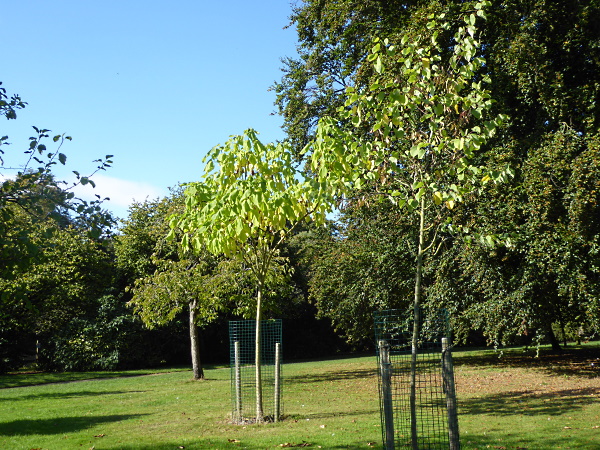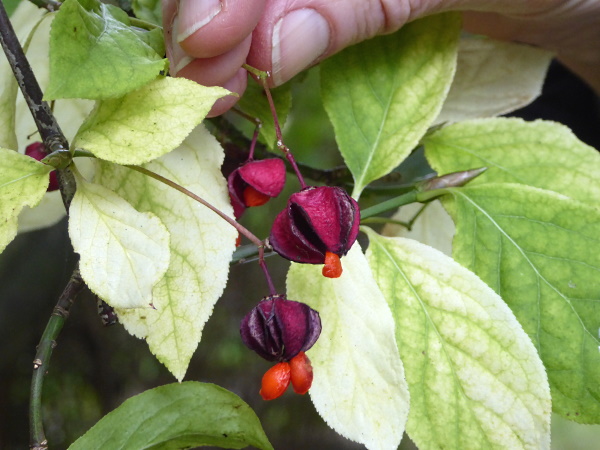
We had another opportunity for a rummage around the trees of Calderstones today, because our leader (who loves to identify fast-moving birds and butterflies but is bored by sedentary trees) was recovering from a family celebration. Our first discovery was a surprise – the original Golden Rain tree, which we had thought had been cut down a couple years ago, is still there! For anyone looking, it is near the gates to the private garden at the back of the Mansion House. The tree is still hemmed in by a Yew, but the leaves are visible high in the canopy, reaching for the sun.

Then we headed into the Harthill area of the park and the triangular field which old maps call the Rose Garden. There are some interesting young trees there, and it’s good that the park is being renewed. Two young saplings next to each other were a Judas tree and a Foxglove tree, and nearby was one of about the same age which still had its nursery label attached, saying Carya illinoinensis. I racked my brains, knowing I’d seen the genus Carya somewhere, and guessed it was a Wingnut by the pinnate leaves. But now I look it up I see that it isn’t a Wingnut, it’s a Hickory, and not just any old Hickory but a Pecan nut tree! I think it’s another gamble with climate change, similar to the planting of olives and vineyards in the south of England. Maybe as the seasons get warmer, it will produce nuts. I haven’t even taken a picture of it, but it’s near the Judas and the Foxglove.

Then we had a look at the Golden Rain tree near the pony paddock. The seed-bearing lanterns are developing but aren’t pink yet and none appear to have fallen. We tried to gently pull some down with a hook and string, but only got one. They clearly aren’t ready yet and we’ll have to try again later in the year.

On our way to lunch we stopped to admire a shrubby tree with clusters of small bell-shaped flowers, each with a very narrow opening at the bottom. Despite that, the bees were on them, so their tongues must be long enough to reach the nectar and pollen. I haven’t identified it, but it looks like some kind of Pieris to me, although all of them flower in Spring, not late summer.

After lunch at the north end of the picnic field we rambled slowly back towards the Mansion House, continually distracted by interesting trees. These lovely little red and purple fruits are Korean Spindle Euonymus oxyphillus.

A huge old evergreen tree is a Coigue or Dombey’s Beech Nothofagus dombeyi. It’s the height and girth champion of Lancashire at 16.5 m (54 ft) and 267 cm (8 ft 8 in).


Another pretty little fruit belonged to the Japanese Snowbell Styrax japonicus.

Thick ivy grows on the wall opposite the side of the Mansion House, and over it was growing this lovely late-flowering white Clematis, covered with insects and bees. It must be a cultivated form of the wild Old Man’s Beard Clematis vitalba. It is said to be common in central and southern England “but records quickly diminish as you go north”. Another species on the march northwards, perhaps.

Near the 1000-year-old Allerton Oak the Virginian Witch Hazel was looking sick but the Persian Ironwood was starting to put on its intense autumn colour.

We were intrigued by this lopped knobbly tree trunk, with one or two good branches surviving. Some sort of Maple by the look of it.

Then, after noting a yellow-berried Holly, we headed back to the bus.
Public transport details: Bus 75 from Gt Charlotte Street at 10.10, arriving Menlove Avenue / Compton’s Lane at 10.32. Returned on 75 from Beech Lane / Crompton’s Lane at 2.35, arriving Liverpool 3.00.
